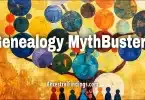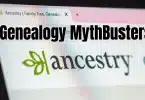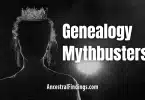For genealogists, the census is like a treasure chest. Those big sheets of names, ages, occupations, and birthplaces are often the first stop when we start tracing a family tree. They feel official, stamped with the authority of the government, and that makes them seem ironclad.
But here’s the myth we need to bust: the census is not always correct.
Yes, census records are invaluable. They offer details you won’t find anywhere else. But they are also full of quirks, errors, contradictions, and missing information. If you take every line at face value, you could easily chase the wrong ancestor or miss the right one altogether.
The good news? Once you understand why the census is imperfect—and how to work with those imperfections—you’ll unlock its real power as a genealogical tool. Let’s dive deep into this myth, explore why mistakes happened, and discover how to read between the lines.
A Quick History of the U.S. Census
The U.S. census began in 1790, and every ten years since then, it has aimed to count every person living in the country. Each census is a product of its time, shaped by politics, technology, and culture.
- 1790 Census: The first census was barebones—only the head of household was listed by name. Everyone else was tallied in categories (free white males, free white females, enslaved persons). Errors were rampant because instructions were vague.
- 1850 Census: A turning point. For the first time, every person in a household was named, with age, gender, and birthplace. Finally, children and wives got recognition in the records.
- 1900 Census: A goldmine. It asked for month and year of birth, year of immigration, naturalization status, and number of children a woman had. But with so much information, mistakes multiplied.
- 1940 Census: Introduced sampling—extra questions asked of 5% of households. Great detail, but inconsistent across the population.
- 1890 Census: Largely destroyed by fire in 1921. Only fragments survive, forcing genealogists to rely on substitutes like state censuses and city directories.
Each census asked different questions, and the accuracy of the answers depended on who answered the door and who held the pen.
Why Census Records Are So Often Wrong
Human Error
Enumerators were local hires. Some were meticulous, others sloppy. If they misheard, they wrote it wrong. If they were tired, details slipped. One overworked enumerator in 1870 admitted he skipped households to “save time.”
Family Guesswork
Not everyone knew the right details. A neighbor or child might give the answers. That’s how your ancestor’s age could swing by five years from one census to the next.
Deliberate Lies
Sometimes people chose to fudge the truth:
- Women might shave off a few years.
- Immigrants sometimes claimed U.S. birth to avoid discrimination.
- Families occasionally hid illegitimate children or altered marital status.
Language and Literacy Barriers
If the enumerator didn’t speak the household’s language, spellings became phonetic guesses. That’s why “Kwiatkowski” could appear as “Quitkosky” in one census and “Watkoski” in another.
Shifting Borders and Identities
Birthplaces can be especially tricky. A man born in Prussia might later be listed as German, Polish, or Russian depending on the political map of the decade. One person, many “birthplaces”—all technically correct.
Case Studies: Census Quirks in Action
- Anna/Annie/Anna Again: Anna Müller appeared as “Annie Miller” in 1900, “Anna Muler” in 1910, and “Mrs. John Muller” in 1920. Without cross-checking, she’d look like three different women.
- The Vanishing Children: In an 1880 record, two siblings were missing entirely because they were at a neighbor’s house when the enumerator came. They reappeared in 1900, confusing future researchers.
- Aging Backwards: My great-grandfather was 35 in 1900, 42 in 1910, and 40 in 1920. He didn’t bend time—he just wasn’t consistent.
- The Irish/English/New Yorker: One man listed Ireland as birthplace in 1900, England in 1910, and New York in 1920. Was he confused? Maybe. More likely, he was adapting his story to fit in.
International Census Quirks
Census headaches aren’t unique to the U.S.:
- Britain: Ages in the 1841 census were rounded down to the nearest 5. A 29-year-old might appear as 25.
- Canada: Remote households were sometimes skipped, leaving gaps in rural areas.
- Ireland: Most census records before 1901 were destroyed, leaving researchers with frustrating holes.
- Germany/Eastern Europe: Shifting national borders meant the same town might appear under different countries in different decades.
Wherever you research, censuses bring value—but also chaos.
Why Census Records Still Matter
So why bother if they’re so flawed? Because censuses give you:
- Snapshots of households: Who was living together, including stepchildren, in-laws, and boarders.
- Clues to migration: Birthplaces of children can trace a family’s moves.
- Occupations: They reveal trades, farming, industry, and even unemployment.
- Community ties: Neighbors often turn out to be relatives or future in-laws.
Even their mistakes can be useful—clues to accents, identity shifts, or family secrets.
Detective Work: Following a Family Across Decades
Let’s follow the Kowalskis:
- 1900 Census: John and Maria Kowalski, both 30, born in Poland, with children Anna (5) and Joseph (3).
- 1910 Census: John is 45, Maria 38, Anna 15, Joseph 12, plus Rose (8). Birthplace listed as Russia.
- 1920 Census: John 50, Maria 48, Joseph 20, Rose 17. Anna is gone—likely married. Birthplace listed as Germany.
At first glance, these look like three different families. But with context—border shifts, flexible ages, and the disappearance of a married daughter—you see it’s the same family.
Tips for Handling Imperfect Census Data
- Expect spelling changes. Use Soundex and wildcards in searches.
- Line up multiple censuses. Look for patterns over decades.
- Treat ages loosely. A five- to ten-year gap is common.
- Check the neighbors. Kin often lived next door.
- Anchor with vital records. Birth, marriage, and death certificates confirm details.
- Follow occupations. A shoemaker in 1900 is probably the same “bootmaker” in 1910.
- Note inconsistencies. Sometimes errors reveal bigger stories (e.g., identity shifts).
Why This Myth Matters
If you assume the census is flawless, you might dismiss a record that doesn’t match perfectly. You might even miss your ancestor entirely. But when you embrace the census as a messy but valuable clue, you open new doors.
A census entry is never the whole story—but it’s almost always a piece of it.
The Real Story
Census records aren’t perfect. They’re human documents, filled with quirks, contradictions, and mistakes. But that’s exactly why they’re so powerful. They don’t just give us raw data—they give us a window into how people remembered themselves, how they wanted to be seen, and how governments captured lives in ink.
The census won’t hand you your family history on a silver platter. But when you approach it with curiosity, flexibility, and a detective’s eye, it becomes one of the richest resources in genealogy.
The real story is this: your ancestors are in there—even if their names are misspelled, their ages are wrong, and their birthplaces keep shifting. Finding them in the tangle of mistakes is part of the adventure, and it makes every discovery all the more rewarding.






